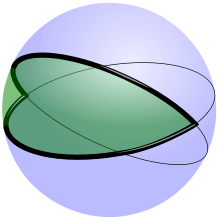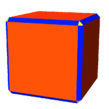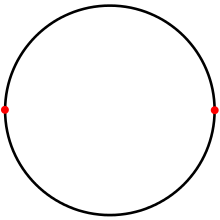Improper regular polygon
In geometry, an improper regular polygon is a regular polygon that has fewer than three sides (edges) and fewer than three vertices. An improper regular polygon is degenerate in a Euclidean plane, but they may be constructed on a sphere. A digon is not degenerate when constructed between two antipodal points on a circle, or on a sphere as a lune.[1]
Monogon
| Monogon | |
|---|---|
|
On a circle, a monogon is a tessellation with a single vertex, and one 360° arc edge. | |
| Type | Regular polygon |
| Edges and vertices | 1 |
| Schläfli symbol | {1} or h{2} |
| Coxeter diagram |
|
| Symmetry group | D1, [ ], (*•) |
| Dual polygon | Self-dual |
In geometry a monogon or 1-gon is a degenerate type of polygon with one edge and one vertex. It has Schläfli symbol {1}[2] and can be constructed as an alternated digon, h{2}.
In Euclidean geometry a monogon with straight sides is an impossible object, because its endpoints must coincide, unlike any Euclidean line segment. For this reason, the monogon is not a proper polygon in Euclidean geometry.
In the geometry of a circle, a monogon can be constructed as one vertex and a 360° arc edge with both ends sharing the same vertex.
On a sphere a monogon can be constructed as a vertex on a great circle (equator). This forms a dihedron, {1,2}, with two hemispherical monogonal faces which share one 360° edge and one vertex. Its dual is the hosohedron, {2,1}, which has two antipodal vertices at the poles, one 360 degree lune face, and one edge (meridian) between the two vertices.[2] A truncated monogon, t{1}, is a digon, {2}.
 Dihedron, {1,2} |
 Hosohedron, {2,1} |
Digon
| Digon | |
|---|---|
|
On a circle, a digon is a tessellation with two antipodal points, and two 180° arc edges. | |
| Type | Regular polygon |
| Edges and vertices | 2 |
| Schläfli symbol | {2} |
| Coxeter diagram |
|
| Symmetry group | D2, [2], (*2•) |
| Dual polygon | Self-dual |
In geometry, a digon, bigon, biangle or 2-gon is a polygon with two sides (edges) and two vertices, and can be represented by Schläfli symbol {2}. Its construction is degenerate in a Euclidean plane, but it may be constructed on a sphere as a pair of 180 degree arcs connecting antipodal points.
In Euclidean geometry
A digon is regular, because its two edges are the same length and its two angles are equal (both being zero degrees).
Some definitions of a polygon do not consider the digon to be a proper polygon because of its degeneracy in the Euclidean case.[1]
In spherical tilings
A spherical polyhedron a nondegenerate digon (with a nonzero interior area) can exist if the vertices are antipodal. The internal angle of the spherical digon vertex can be any angle between 0 and 360 degrees. Such a spherical polygon can also be called a spherical lune.
A truncated digon, t{2} is a square, {4}. An alternated digon, h{2} is a monogon, {1}.
-

One antipodal digon on the sphere.
-

Six antipodal digon faces on a hexagonal hosohedron tiling on the sphere.
In polyhedra
A digon is considered a degenerate face of a polyhedron because it has no geometric area and edges are overlapping. But sometimes it can have a useful topological existence in transforming polyhedra.
Any polyhedron can be topologically modified by replacing an edge with a digon. Such an operation adds one edge and one face to the polyhedron, although the result is geometrically identical. This transformation has no effect on the Euler characteristic (χ = V − E + F).
A digon face can also be created by geometrically collapsing a quadrilateral face by moving pairs of vertices to coincide in space. This digon can then be replaced by a single edge. It loses one face, two vertices, and three edges, again leaving the Euler characteristic unchanged.
Classes of polyhedra can be derived as degenerate forms of a primary polyhedron, by bringing pairs or groups of vertices into coincidence. For example, the following uniform polyhedra with octahedral symmetry exist as degenerate forms of the truncated cuboctahedron (4.6.8).
| Polyhedron | Cube | Truncated cube | Truncated octahedron | Octahedron | Cuboctahedron | Rhombicuboctahedron | Truncated cuboctahedron |
|---|---|---|---|---|---|---|---|
| Image |  |
 |
 |
 |
 |
 |
 |
| Vertex figure | (2.4)3 | 3.8.2.8 | 2.6.4.6 | (2.3)4 | (3.4)2 | 3.4.4.4 | 4.6.8 |
In these pictures, the edges between red faces in the first two polyhedra and yellow faces the third and fourth can be seen as blue degenerate digonal faces {2}. In the cube, the yellow faces degenerate into points, in the octahedron, the red faces degenerate into points, and in the cuboctahedron the blue faces degenerate to points. This principle is used in the Wythoff construction.
See also
References
- Herbert Busemann, The geometry of geodesics. New York, Academic Press, 1955
- Coxeter, Regular Polytopes (third edition). Dover Publications Inc. ISBN 0-486-61480-8
- Weisstein, Eric W., "Digon", MathWorld.
- A.B. Ivanov (2001), "Digon", in Hazewinkel, Michiel, Encyclopedia of Mathematics, Springer, ISBN 978-1-55608-010-4
External links
| Wikimedia Commons has media related to Digons. |
| Look up monogon or digon in Wiktionary, the free dictionary. |
- Olshevsky, George, Monogon at Glossary for Hyperspace.
| ||||||||||||||||||||||||||

